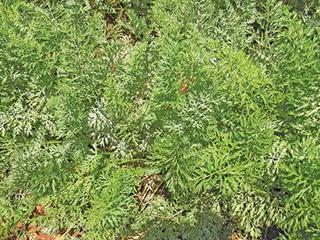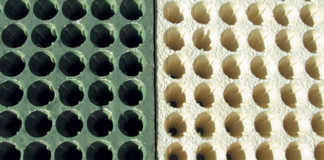
Cercospora
Unlike Alternaria, which starts on older leaves, Cercospora prefers younger leaves. The spots on the leaves are small, circular and tan to grey-brown, and first occur along the edges of the leaves, often causing them to curl. As the number of spots increase, the entire leaf can wither and die.
When Cercospora attacks the petioles, it creates elongated brown lesions with tan centres.
The spots leave craters, making identification much easier, as the other leaf blight diseases do not do this.
Cercospora can also attack the stems of carrot seed stalks during seed production, which is the source of seed-borne infection.
One of the reasons that seed is produced in dry areas is to reduce the possibility of introducing leaf blight diseases through the seed.
Hot, wet weather favours the development of the disease, although it has a wide temperature range.
Control : Apply a copper-based product and a dithiocarbamate as a preventative measure. However, if symptoms develop at a time when conditions favour the disease, contact your pest control representative for advice on a suitable systemic product.
Bacterial leaf blight
This disease is less well known than the other two. It is important to know how to recognise it, as the treatment is different.
Early signs are small yellow areas on the leaflets. The centres become brown and dry, and are often surrounded by the yellow halo common to most bacterial diseases.
Later, irregular brown spots appear on the leaves and brown streaks on the petioles and stems.
Mature foliage symptoms are indistinguishable from leaf blights caused by Alternaria and Cercospora.
As with most bacterial diseases, spread can be rapid. Like the other leaf blights, it can survive on crop debris. A three-year rotation will therefore help control the disease.
Bacterial blight is spread by driving rain, wind, water splash and traffic through the land, especially when the foliage is wet.
Control: To control Bacterial Leaf Blight, it is essential to use products containing copper; other fungicides will have no effect on the bacterium. For this reason, ensure that copper is one of the products used during rotation.
Powdery mildew
Carrot varieties differ greatly in their susceptibility to this disease. Unlike the leaf blights, powdery mildew is more of a problem in hot, dry conditions, as the fungus spores do not need free water on the leaf surface to germinate.
Some farmers ignore the disease if it appears at an advanced stage of plant growth, as the roots are just about fully developed and the yield is unlikely to be affected.
This may be so, but powdery mildew affects the eating quality of carrots, which influences demand for the product as well as the price obtained.
Powdery mildew usually starts off on older leaves, but all leaves can become infected.
When it develops on younger carrots, it will affect the yield and the leaves will start to die off. Look for a powdery, white fungus on the surfaces of the leaves.
Control: The disease can spread very rapidly, but is easy to control with systemic products.












